Maisha Card (3rd Generation ID): Your FAQs Answered


- What is a Maisha Card (3rd generation ID)?
This document will bear the Maisha Namba. It will replace the current 2nd generation ID. It will feature enhanced security details, including a microprocessor electronic chip with encrypted data that is difficult to forge or manipulate. The card will include a photo image of the applicant, an ID number, a card serial number, biometric data, biographic data, residential particulars, and high-end security features.
- Why is the government replacing the 2nd generation ID with the 3rd generation ID?
- Unlike the 2nd generation ID, the 3rd generation ID complies with the 2010 Constitution of Kenya, which introduced significant changes to the country’s administrative divisions. It replaced the previous district system with a county-based system. In the 3rd generation ID, administrative units have been realigned to match the new administrative boundaries by introducing counties and aligning districts with sub-counties.
- Kenya is a member of the United Nations, and as per Sustainable Development Goal (SDG) No. 16.9, member countries are required to provide access to legal identity for all. The third-generation ID conforms to this requirement by enhancing the national identification ecosystem and improving access to legal identity registration services, thus helping Kenya align with UN SDG Goal 16.9. Kenya is a signatory to the East Africa Common Market Protocol that requires member countries to issue electronic national ID cards which conform to the International Civil Aviation Organisation (ICAO) prescribed standards for travel documents.
- The underlying production technology has been in place for 28 years and has reached an unattainable level of obsolescence; therefore, it needs to be replaced with modern technology.
- Advancements in ICT and identification technologies have made the current card increasingly vulnerable to counterfeiters due to outdated security features.
- While the current 2nd generation ID has been upgraded to plastic (Teslin) material, Teslin cannot support an integrated chip. Adopting polycarbonate material would allow for the inclusion of a chip and enhance the security functionality of the card by allowing other authorised agencies to validate the card.
- The 2nd generation ID primarily uses fingerprint biometrics for personal identification. Including other biometrics, e.g. facial recognition, will provide additional means for identification.
- The manual indexing and filing of statutory registration records is outdated, insecure and unreliable. Retrieval of statutory records is labour- and time-intensive and inefficient. An adequately integrated EDMS system will ensure records are availed efficiently at the point of use.
- Implementing the 3rd generation ID system will promote a customer-centric approach by fast-tracking registration and issuance of ID cards. Applicants will be able to interact with the system and get feedback on the status of their ID application.
- The 3rd Generation ID card will be a secure polycarbonate electronic card installed with a machine-readable chip for data storage and retrieval to enhance validation of the card by user agencies.
- The current ID card system is semi-automated. The system consists of identification and manual enrolment processes at field stations, central data processing, ID card production and data archival. The new system will manage the data of all registered citizens, refugees, and foreigners on the fingerprint biometric technology platform, which enhances data accuracy and reliability. The system matches the fingerprints of an application to fingerprints stored in the database. It helps detect cases of double and illegal registration.
- What are the benefits of the Maisha Card (3rd generation ID)?
- A national electronic ID card compliant with ICAO standards will enable Kenyan citizens to use it as a travel document within the East African community.
- Automating the registration processes will enhance efficiency in the ID registration process, improve access to registration services, and reduce the cost of doing business in ASAL and remote areas.
- Modernising the ID processing systems, equipment, and materials will result in issuing a more secure identification document, thereby reducing counterfeiting.
- Modernising the ID and its processing system will make the delivery of government services faster, more efficient, and transparent.
- Upgrading AFIS to ABIS will create a more inclusive identification system.
- The electronic card will facilitate more efficient validation of personal identification data by public and private institutions, thereby simplifying citizens’ access to services.
- What is AFIS and ABIS?
AFIS stands for Automated Fingerprint Identification System, while ABIS stands for Automated Biometric Identification System. Both systems are used to determine the uniqueness of individuals using their biometrics. AFIS specifically utilises fingerprint biometry, while ABIS includes other biometrics such as facial recognition.
- Will I need to replace my ID with the 3rd generation ID?
Replacing your ID is optional. However, should you wish to access the benefits of the 3rd Generation ID, you will need to replace your 2nd Generation ID.
- What will happen to my Maisha Card after ten years? What will I need to do?
As a cardholder, you must apply for a duplicate and surrender the older card upon
collecting the new one. The older card will be perforated, as is currently done with
expired passports.
Source: Ministry of Interior and National Administration; State Department for Immigration and Citizen Services

